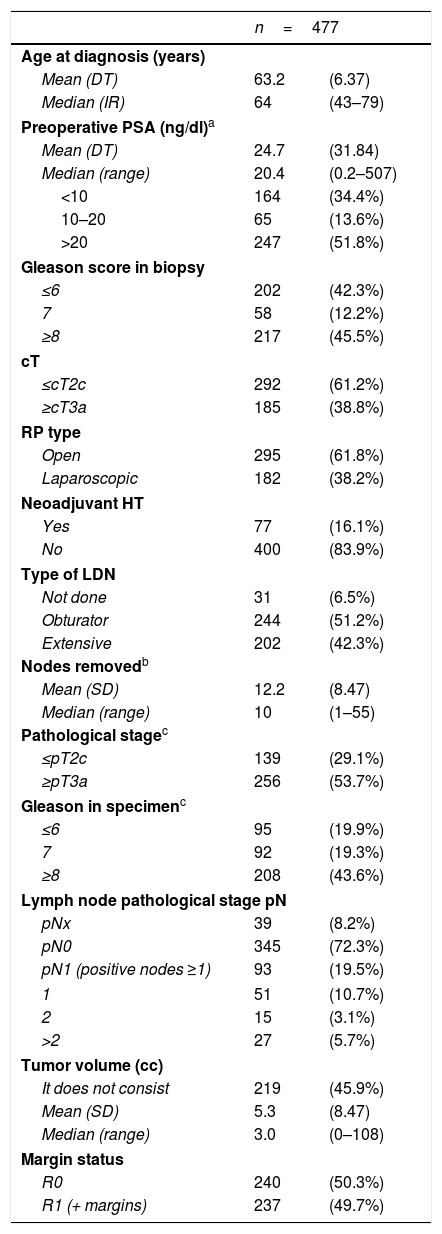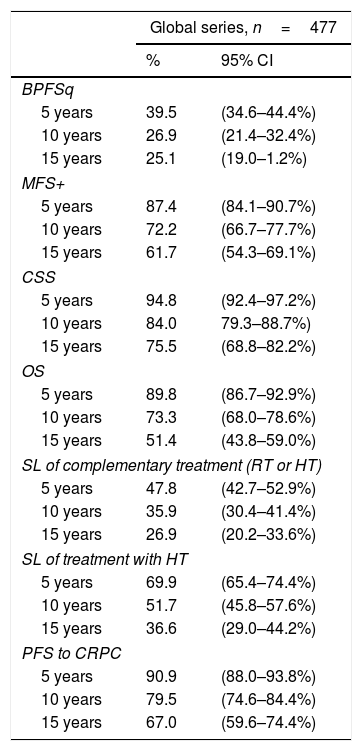To analyze the most relevant oncologic results of treatment using radical prostatectomy (RP) for high-risk prostate cancer (HRPC) in a specialist cancer hospital.
Material and methodsA descriptive retrospective study of RP was conducted at our center from 1986 to 2017 on HRPC whose primary objective was to determine overall survival (OS) and cancer-specific survival (CSS). The study's secondary objectives were to determine biochemical progression-free survival (BPFS), metastasis-free survival (MFS), rescue therapy-free survival (RTFS), hormone therapy-free survival (HTFS) and the development of castration-resistant prostate cancer. We performed a Cox regression analysis to establish predictive models and to better understand the weight of each variable that defines high risk.
ResultsA total of 2093 RPs were performed, 480 (22.9%) of which were for HRPC. The median follow-up for the overall series was 79.57 months (P25–75 37.92–135.16). Lymphadenectomy was not performed in 6.5% of the cases. The lymphadenectomy was of the obturator type in 51.2% of the cases and extended in 42.3%. Overall survival at 5, 10 and 15 years was 89.8% (95% CI 86.7–92.9%), 73.3% (95% CI 68–78.6%) and 51.4% (95% CI 43.8–59%), respectively. CSS at 5, 10 and 15 years was 94.8% (95% CI 92.4–97.2%), 84.0% (95% CI 79.3–88.7%) and 75.5% (95% CI 68.8–82.2%), respectively. MFS at 5, 10 and 15 years was 87.4% (95% CI 84.1–90.7%), 72.2% (95% CI 66.7–77.7%) and 61.7% (95% CI 54.3–69.1%), respectively. A total of 120 patients of 477 analyzed (25.1%) required rescue radiation therapy, and 293/477 never required hormone therapy (61.4%). Of the 93 pN1 patients, 33 (35.5%) did not require hormone therapy. The time from RP to biochemical progression was the variable with the greatest prognostic weight for MFS, CSS and overall survival.
ConclusionsRP plus extended lymphadenectomy should be the first therapeutic maneuver when feasible within a multimodal strategy. A longer follow-up of the series is needed to validate the hypothesis of better oncologic results based on the earlier implementation of rescue radiation therapy, extended lymphadenectomy and drugs that prolong survival in the CRPC phase.
Analizar los resultados oncológicos más relevantes en el tratamiento mediante prostatectomía radical (PR) en el cáncer de próstata de alto riesgo (CPAR) en un hospital oncológico.
Material y métodosEstudio retrospectivo descriptivo de las PR realizadas en nuestro centro desde 1986 a 2017 en CPAR para conocer como objetivo primario las supervivencia global (SG) y cáncer específica (SCE), y como objetivos secundarios las supervivencias libre de progresión bioquímica (SLPB), libre de progresión metastática (SLPM), la necesidad de tratamiento de rescate (SLTR), la necesidad de hormonoterapia (SLHT) y finalmente el desarrollo de cáncer de próstata resistente a la castración. Se realizan análisis de regresión de Cox para establecer modelos predictivos y conocer el peso de cada variable definitoria de alto riesgo.
ResultadosSe realizaron 2.093 PR de las cuales 480 (22,9%) fueron en CPAR. La mediana de seguimiento de la serie global fue 79,57 meses (P25-75 37,92-135,16). No se realizó linfadenectomía (LDN) en el 6,5% de los casos, mientras que fue LDN obturatriz en 51,2% y extensa en 42,3%. La SG a 5, 10 y 15 años fue de 89,8% (IC 95%: 86,7-92,9%), 73,3% (IC 95%: 68-78,6%) y 51,4% (IC 95%: 43,8-59%). La SCE a 5, 10 y 15 años fue de 94,8% (IC 95%: 92,4-97,2%), 84,0% (IC 95%: 79,3-88,7%) y 75,5% (IC 95%: 68,8-82,2%) La SLPM a 5, 10 y 15 años fue de 87,4% (IC 95%: 84,1-90,7%), 72,2% (IC 95%: 66,7-77,7%) y 61,7% (IC 95%: 54,3-69,1%) respectivamente. Se requirió radioterapia de rescate en 120 pacientes de 477 analizados (25,1%) y 293/477 nunca han requerido hormonoterapia (61,4%). En relación con el uso de HT en los 93 pacientes pN1, 33 (35,5%) no la han necesitado. El tiempo desde la PR a la progresión bioquímica es la variable de mayor peso pronóstico para la SLPM, la SCE y la SG.
ConclusionesLa PR más LDN extensa debería ser la primera maniobra terapéutica cuando es factible dentro de una estrategia multimodal. Es necesario un seguimiento mayor de la serie para validar la hipótesis de unos mejores resultados oncológicos basándose en una aplicación más precoz de la RT de rescate, una LDN extensa y los fármacos prolongadores de supervivencia en la fase de CPRC.












